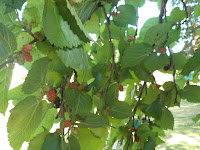Legend has it that Andrew Marvell, the local MP and renowned poet, would sit beneath the tree as a boy. The trouble with the legend, however, is that it is probably wrong. We have no evidence for the date of the tree's planting. Marvell came here as a child of 3, in 1624, when his father became Master, and he left aged about 12 to go off to college. He rarely came back home. The current Master's House did not then exist, and all the buildings of the hospital were demolished in 1642 to make way for a defensive garrison at the outset of the Civil War. Rebuilding began in 1649, and was completed in around 1673, when William Catlyn added a chapel. There is some evidence that the footprint of the new buildings was very different from that of the original hospital. Was the new Master's House and garden sited to accommodate the mulberry tree? A more plausible theory is that the tree is a contemporary of those at Wilberforce House, which was also built by William Catlyn.
We know that black mulberries were introduced into Britain in the 17th century in the hope of developing a home-grown silk industry, but the project had to be abandoned when it was realised that silkworms ate only the white variety.
Our tree survived, protected from encroaching development in its sheltered garden. It came through the second World War, despite the unexploded bomb which was found in the garden early in the war, and despite the bomb which did explode in May 1941, badly damaging the Master's House and forcing the evacuation of the Charterhouse. It then survived years of abandonment and neglect; the Charterhouse did not reopen until 1948, and it was the mid-1950s before the Master's House was restored.
At some point it was clear that age was taking its toll.
Steps had been taken, somewhat crudely, to prop it up with wood and wire meshing. Nonetheless it has continued to bear fruit, some years in great quantity. Residents have always made pies and other desserts from the sharp, tangy berries. 2019 has been a bumper year. And it was, perhaps, that which was the tree's downfall - literally. The weight of the fruit, together with the very dry summer, was too much for tree to take, and a huge bough simply broke away. The Matron, Lynne Broom, took photographs of the damage before the clear-up began.
On Wednesday 28 August a BBC reporter from the Look North programme was alerted and arrived with her camera.
Cutting away the fallen branch.
The reporter displays the damage and explains the history.
Edward Hudson, our contract gardener, explains what has happened to the tree.
The Master, Canon Greenwell, expresses hope that it can be saved.
The Yorkshire Post had seen our Facebook page post with the Matron's photo and, the next day, published an article (with some historical inaccuracies) headlined Legendary Yorkshire tree which survived English Civil War and the Blitz may have to be felled and using Lynne's photo.
Can the tree survive? It's hollow, but enough live wood remains to give us hope that it can be saved. Watch this space.
UPDATE 23 July 2020
The mulberry tree survived!
Looking rather lop-sided, nonetheless it's in full leaf, and we may yet see some fruit. Let's hope the weight doesn't bring it down. Another winter may see it off, but fingers crossed.
UPDATE 3 JUNE 2021










No comments:
Post a Comment